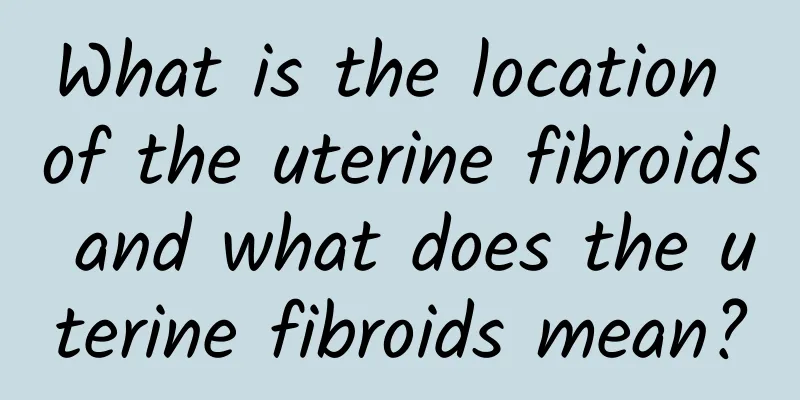What is the location of the uterine fibroids and what does the uterine fibroids mean?

|
What is the location of the uterine fundus wall of uterine fibroids? The uterine fundus wall of uterine fibroids is a location of uterine fibroids, which refers to the uterine fundus part of the myometrium under the endometrium. Let's take a closer look at the location and significance of the uterine fundus wall of uterine fibroids. 1. What is uterine fibroids on the fundus wall? Uterine fibroids are a common benign tumor in women. The part located in the myometrium under the endometrium is called the uterine fundus wall. The uterine fundus wall is the bottom of the uterus and the part in contact with the uterine wall. It is usually located at the top of the uterus. The uterine fundus wall refers to the location where uterine fibroids grow at the bottom of the uterus. 2. The significance of uterine fibroids on the uterine fundus 1. Impact on fertility: The location of uterine fibroids on the uterine fundus directly affects the implantation of the embryo and the contraction of the uterus, thus adversely affecting fertility. If uterine fibroids grow on the uterine fundus, the endometrium will be uneven, affecting the implantation of the fertilized egg in the endometrium, leading to infertility or habitual miscarriage. 2. Cause menstrual disorders: The growth of uterine fibroids on the uterine fundus wall can cause changes in the endometrium, resulting in irregular menstruation, excessive or insufficient menstrual flow, and other menstrual disorders. These adverse menstrual conditions can cause great physical and psychological distress to women. 3. Compression of the bladder and rectum: When the mass on the uterine fundus wall of uterine fibroids grows, it may compress the bladder and rectum, causing symptoms such as frequent urination, urgency, and constipation. In severe cases, serious complications such as difficulty urinating and defecation may also occur. 3. Treatment of uterine fibroids on the uterine fundus 1. Drug treatment: For mild uterine fibroids on the uterine fundus, oral medications can be taken to relieve symptoms and reduce the size of the tumor. Commonly used drugs include progesterone, contraceptives, etc. 2. Surgical treatment: For larger and more severe uterine fibroids on the uterine fundus, surgery is the preferred treatment method. Common surgical methods include myomectomy, myomectomy, uterine fibroid embolization, etc. The doctor will choose the most suitable surgical method based on the condition and the patient's specific situation. 3. Radiofrequency ablation and radiofrequency cryotherapy: This is a relatively non-invasive treatment method that can effectively reduce the size of the tumor, relieve symptoms, and does not affect fertility. It is suitable for some small fibroids located on the bottom wall of the uterus. When treating uterine fibroids, the most appropriate treatment method should be selected based on the patient's specific situation and the doctor's advice. Early detection and treatment of uterine fibroids can help alleviate symptoms, protect fertility, and avoid complications. The uterine fibroids on the uterine fundus are a location where uterine fibroids grow. Their location determines their impact on fertility and menstrual conditions. Treatment of uterine fibroids on the uterine fundus can be achieved through medication, surgery, radiofrequency ablation, and radiofrequency cryotherapy. Early detection and treatment of uterine fibroids on the uterine fundus are of great significance to women's health and quality of life. |
Recommend
What to eat to cure uterine fibroids quickly? What to eat to cure uterine fibroids quickly?
Uterine fibroids are a common benign disease in w...
Dysfunctional uterine bleedingDysfunctional uterine bleeding causes
Dysfunctional uterine bleedingDysfunctional uteri...
Calf cramps and pain? Learning this stretching exercise not only eliminates cramps, but also makes the calf curve tighter and longer.
This exercise is very effective for stretching th...
What are the main symptoms of cervical erosion?
Among gynecological diseases, cervical erosion is...
Can ovarian cysts be treated with puncture?
Can ovarian cysts be treated with biopsy? Ovarian...
Why do symptoms of threatened miscarriage occur?
Symptoms of threatened abortion are usually cause...
Brief analysis of the three common nursing methods for dysmenorrhea
Dysmenorrhea is a common gynecological disease. M...
The symptoms of chronic cervicitis can be divided into three categories
Cervicitis can be divided into chronic cervicitis...
Postpartum aerobic body shaping to regain your graceful figure
Every new mother is most concerned about not bein...
What are the symptoms of uterine fibroids?
The uterus is a fertile place that produces menst...
Precautions for abortion
Things to note when having an abortion: (1) Routi...
Detailed description of the symptoms of vaginal candidiasis
Vaginal candidiasis is a common gynecological dis...
Is stubborn fat too hard to lose? 5 tips to fight allergies and lose weight faster!
If you can’t lose weight, it may be due to allerg...
Tips to relieve vulvar itching
Vulvar itching may be caused by poor hygiene habi...
Treatment of ovarian cysts should be based on type of treatment
Ovarian cysts are mainly divided into 4 types, an...









